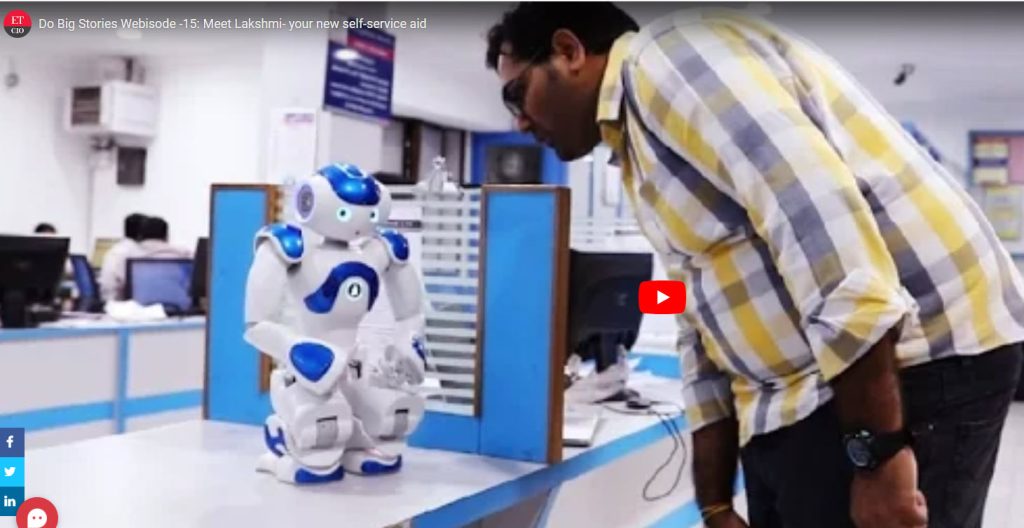AI is the buzzword in the tech world right now. Any software developer today meeting a client will first try to project how AI is built into his product to make it more efficient and cost effective. Every industry is falling over each other to adopt AI and Indian Banks are not far behind in their enthusiasm.
In 2016 itself there was a series of initiatives taken by different Banks to introduce Chatbots on their websites. SBI, SBI Cards, HDFC Bank, ICICI Bank, Axis Bank, Yes Bank, IndusInd bank, Kotak, Andhra bank all released their versions of Chatbots. City Union Bank of Kumbakonam however became the first Indian Bank to introduce a robot to answer queries of its customers on the counter.

Most of the Chatbots were of little practical use and often an irritant to the customer. Even now many website services depend so much on the in-efficient chatbots that we often feel running away from such sites. These chatbots could only respond to specific queries for which answers are already loaded and any small deviation could make it useless.
However, the advent of ChatGPT and the current generation of humanoid robots have made a difference.
The above are the pictures of two News Anchor robots introduced by TV channels (Lisa in Odissa and Soundarya in Karnataka) who look very human and speak like humans.
The Geneva conference where several highly intelligent and interactive robots lead by Sophia, and participated by Nadine , Desdemona, Ameca, Grace, Al-da, and three others, showcased the power of AI driven humanoid robots which can think and act on their own.
It is therefore natural that the resource rich Indian banks will soon bring in the human looking robots to their counters at least one in every branch.
Is this an innovation that we should all welcome? Or one that we should all fear? will be a question we should ponder.
Decision makers in Banks need to take a call now if they have to introduce AI as a marketing gimmick or for functional use.
The use of AI in the front office is imminent and will be a common place in Banks like ICICI Bank and HDFC Bank soon which are generally ahead in technology adoption.
Apart from the human looking robots walking around a branch and greeting customers, there are other ways where AI will be used by the banks. In the middle office, AI applications will be used for automated customer identification and authentication and triggering customer specific responses with personalized insights and recommendations. Fraud prevention will be one of the most important aspects of this middle office AI applications.
In the back office , many of the computerised operations of today will transform to be led by AI. Loan processing, Credit rating etc will become automated and dependent on the AI.
While a part of the industry is excited with the possibilities of innovation and changing face of Banking, there is a thread of worry creeping up in certain circles.
Some of the concerns of AI usage are in the area of Privacy. Most Data Protection laws including the forthcoming Indian law DPDPB 2023 will consider automated processing and automated decision making as privacy issues that need explicit consent.
The concept of “Explicit Consent” is not satisfied by a disclaimer such as “You are under CCTV surveillance” or “You will be serviced by a robot” etc since it does not specify that the CCTV or the robot is not processing the face recognition to identify the customer and checking his background as well as his transactional history.
Getting a valid consent for such use of AI is the first priority for the Banks.
If AI is used in back-end processing for Profiling, Credit rating and Loan eligibility determination or for determining the risk adjusted interest rates then the need for establishing a legal basis is accentuated with the need for algorithmic transparency and establishing absence of decision bias.
Over and above this, if there is an incorrect decision by the AI, the liability has to be fixed on the Bank and the Bank should be able to transfer this to the AI robotic manufacturer as an “Intermediary”.
While in fraud prevention, the AI can be used very effectively, to monitor the transactions, to identify the abnormality and to stop phishing frauds, if the AI is not configured properly or if AI can be bypassed by the hacker, the responsibility for the Bank continues even after it could have turned complacent with the introduction of AI led fraud monitoring system.
Hence there is a need for the Banks to monitor the functioning of the AI Fraud monitoring system or any other system by humans. However since humans surrender their work to AI because they cannot handle the volume and complexity, even the monitoring needs technology assistance.
I therefore foresee a need for second level AI tools that monitor the first level AI tools to identify the anomolus behaviour of the AI tool itself and any exceptions it could have allowed..like setting a thief to catch a thief.
This system would be like “Officer level AI tools” monitoring “Clerical level AI tools” and introducing the dual check rule in the AI Banking world.
As an example, the CCTV in a Bank premises can watch the walking humanoid robot’s behaviour and identify if it is doing its duty properly and not ignoring a senior citizen who needs help or flirting with a handsome customer or showing a rogue behaviour like “Sydeney” the Bard assistant.
In the context of decision making AI algorithms, the Checking algorithms may review a sample of decisions and apply fraud detection patterns and identify if everything was on board.
I hope that Banks who are trusted repositories of public money will first think of such controls before falling into the marketing glib talk of technology suppliers and introduce inefficient AI. If this happens it would be a great risk.
In the context of several Indian Banks having been declared Section 70 (Protected System) systems, the AI usage has to be vetted and approved by CERT IN.
I therefore advise caution to the Indian Banks before gong ga-ga about AI introduction in their activities.
Naavi








